- Karachay folk music
- Special tunes
- The classes of Karachay folk music
- Class 1: Rotating and plagal motion (№ 1−8)
- Class 2: One or two short lines and their variations with x(1)1 cadences (№ 9-37)
- Class 3: Four short lines with (1) main cadence (№ 38-53)
- Class 4: Four short lines with the first line ending on the key note, with a (pseudo) domed structure and 1(x)y cadences (№ 54−62)
- Class 5: Four short lines with (VII) main cadence (№ 63−70)
- Class 6: Four short lines with (2) and (b3) main cadences (№ 71−105)
- Class 7: Four short lines with (4/5) main cadences (№ 106−115)
- Class 8: Four short lines with (4/5) main cadence and a higher beginning (№ 116−138)
- Class 9: Four short lines with (7/8) main cadences (№ 139−145)
- Class 10: One- or two-lined tripodic tunes (№ 146–186)
- Class 11: Tunes with four tripodic lines (№ 187–199)
- Class 12: Jir tunes (№ 200–278)
- Class 13: Four long lines with arched (domed) structure (№ 279–287)
- Connections between Hungarian and Karachay folk music
Class 10: One- or two-lined tripodic (archaic) tunes (№ 146–186)
Until now, tunes built of two or four short (two-bar) lines have been dealt with. We have also seen tunes of two four-bar lines which may be taken for four short lines as well. Now, in Class 10, there are three-bar tunes the lines of wich are long but not divisible. The genre and melodic realm of tripodic tunes are mostly archaic and the performing style is rubato, which justifies their separate treatment.
The tunes of Class 10 include several that have been extended to a many-line scheme from one or two lines. If they descend to the final note at the and of the second line, in the classification only the first two lines of these seemingly four- or more sectioned tripodic melodies are taken into account..
Group 10.1 has two unique tunes of Aeolian-Phrygian character (№ 146 and Ex.10.1). What lends them their singularity is first of all that an important cadence is below the final note. This phenomenon occurs very rarely, let alone in an emphatic position at the end of a line. Moreover, the end of the first line
of Ex.10.1 jumps from the VIIth degree to b3 and its second line closes on degree V.
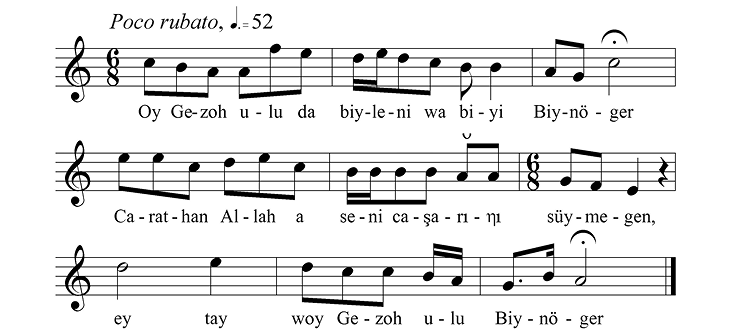
Ex.10.1. Special three-lined tripodic tune
Group 10.2 is characterized by 1/2(1)b3/4 cadences. It has only two minor-scale tunes (№ 148–149), and № 148 can only be taken for tripodic with reservations. By contrast, among the mixolydian-character tunes there are surprisingly many tunes descending to the key note. These tunes display archaic features in music and lyrics alike, and are highly popular (Ex.10.2, as well as № 147 and 163–169).14
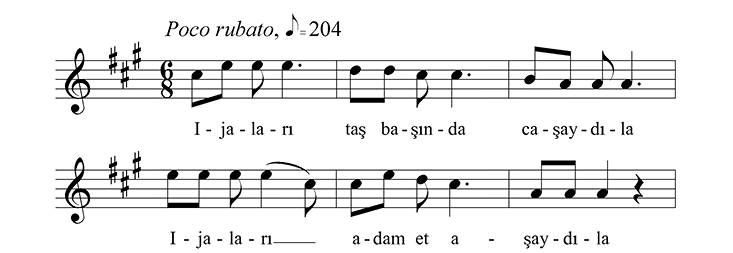

Ex.10.2. Tripodic tune traceable to AABA form
The large 10.3 group solely contains mixolydian tunes with (2) main cadence (№ 170–179 and Ex.10.3), some of which resemble to some extent the small form of Hungarian and Anatolian laments, but the majority display considerable differences such as a leap to the fifth below the final note (№ 171) or the #G-A line ending (Ex.10.3). These turns and the giusto performance of the line pairs are alien to the realm of Hungarian and Anatolian laments. At the same time, the free performance, the improvisatory handling of the lines, the descending and convex melody lines are all reminiscent of the world of Hungarian and Anatolian laments (e.g. № 170, № 174 and № 176).
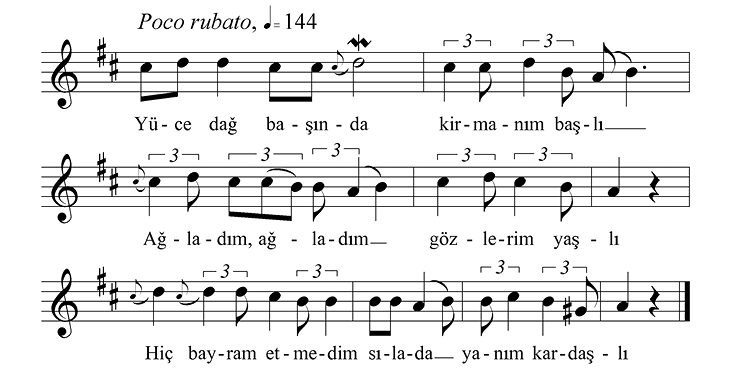
Ex.10.3. Lamenting tripodic tune
The relatively large group 10.4 is dominated by minor-character tunes with (b3) main cadence (№ 150–156 and Ex.10.4).15 They can be split into two groups: in one the melody leaps to the b3 cadential note from the lower fifth (or occasionally from its leading note), in the other there is descent to the b3 cadence. (A similarly distinct motif of an upward jump already occured in group 10.3.) The only tune with (3) cadence and a mixolydian scale has descending lines (№ 180).
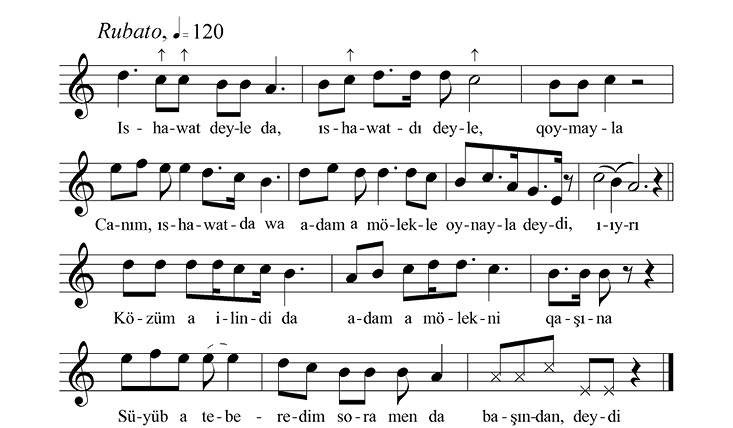
Ex.10.4. Tripodic tune with 3(1)x cadences
Most Aeolian-Phrygian tunes in groups 10.5–10.7 are isometric, in the groups the first lines descending from higher than in the previous one. That also applies to some of the mixolydian tunes, except for Otarov’s № 183 starting in a unique way, № 184 which ends with a fourth leap upward and the relatively freely extemporized № 186 performed rubato.
Group 10.5 consists of popular minor (№ 157–158 and Ex.10.5a) and mixolydian (№ 181–184 and Ex.10.5b) tunes with (4) main cadence.
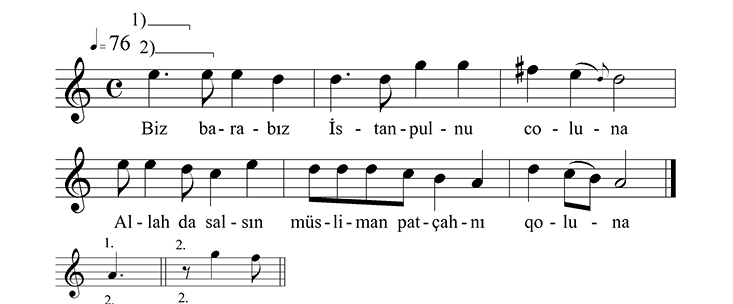
Ex.10.5a. Two-lined tripodic tune with (4) main cadence
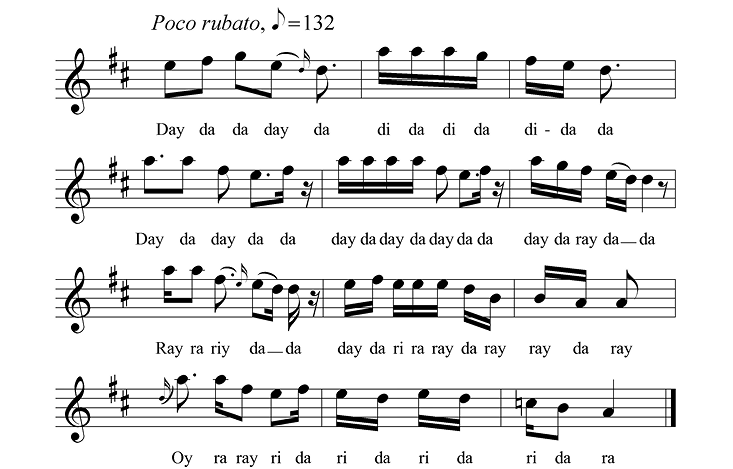
Ex.10.5b. Tripodic Karachay lament traceable to a bipodic structure
In addition to the popular minor-scale № 159–161 and Ex.10.6 with (5) main cadence, there is a single mixolydian fifth-shifting tune (№ 185) in group 10.6.
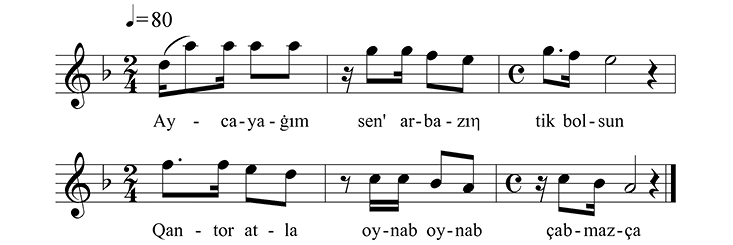
Ex.10.6. Two-lined tripodic tune with (5) main cadence
Group 10.7 of tripodic tunes in which the first line ends high (degree 6/7) only contains two songs: № 162 of Dorian character and № 186 of a major scale.16
